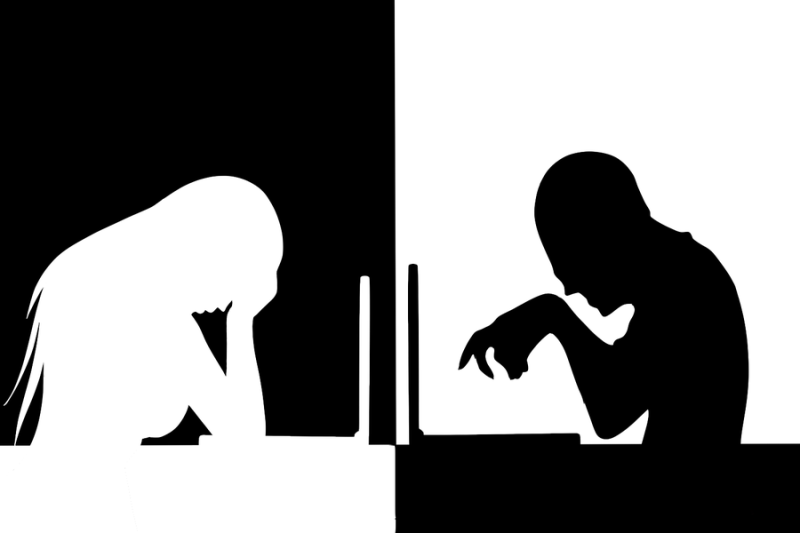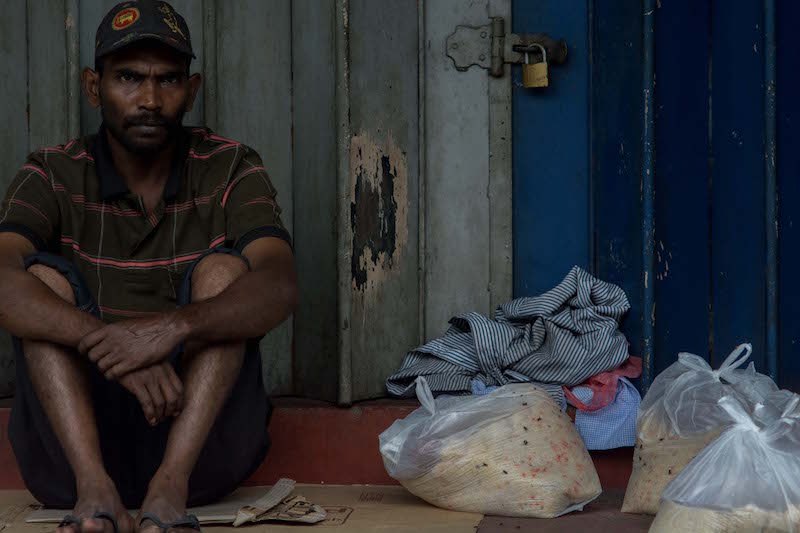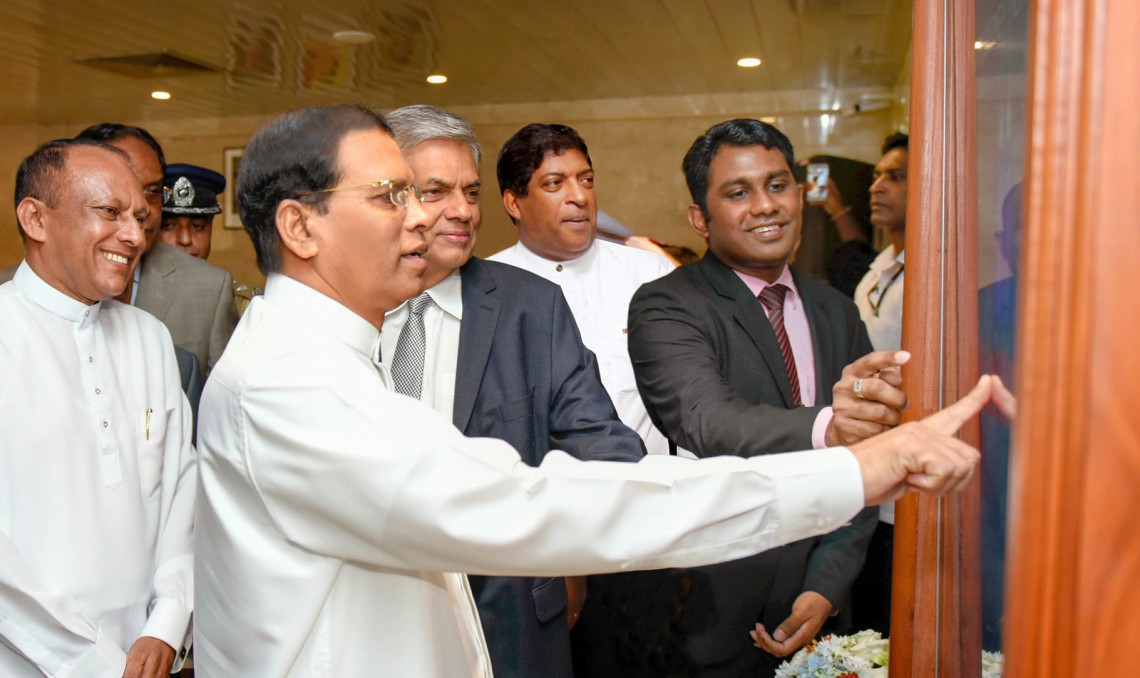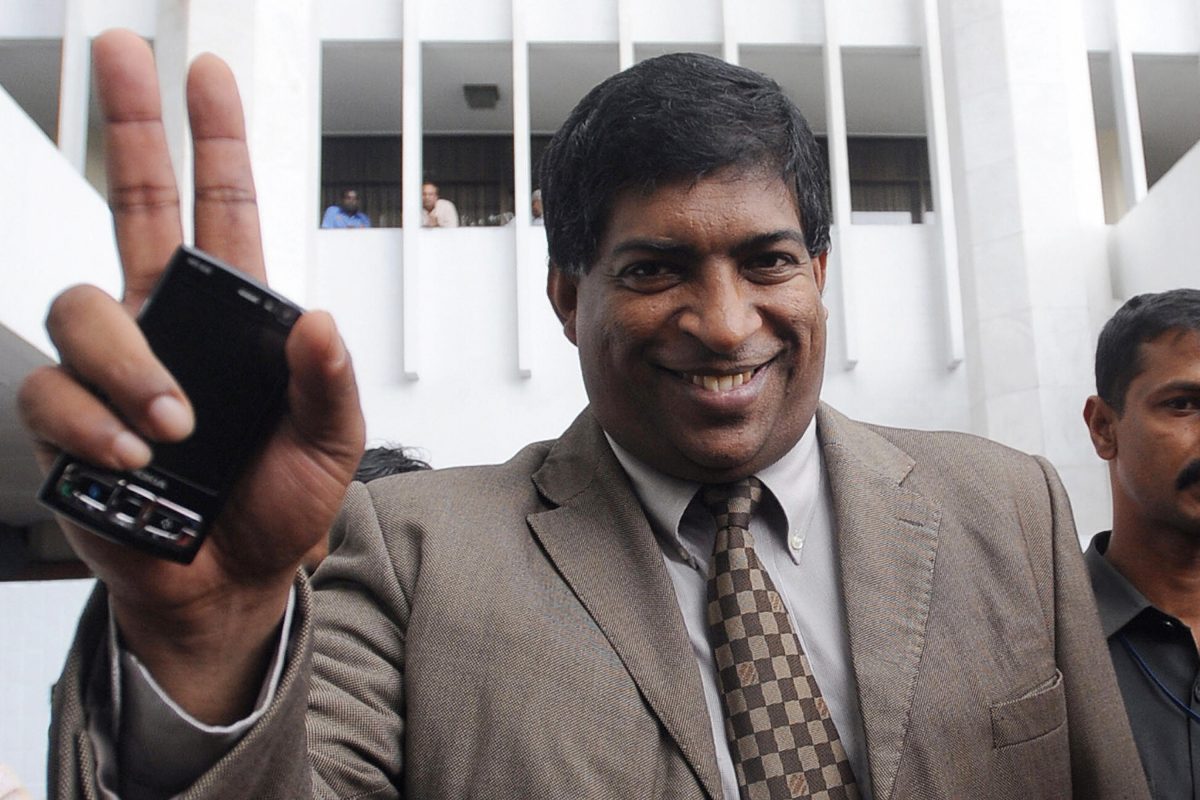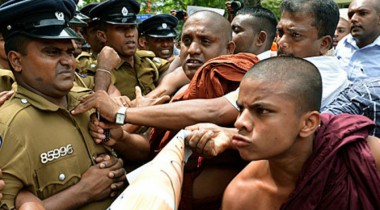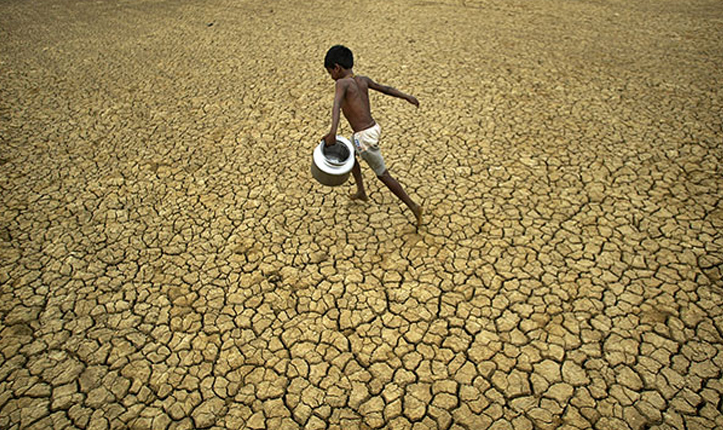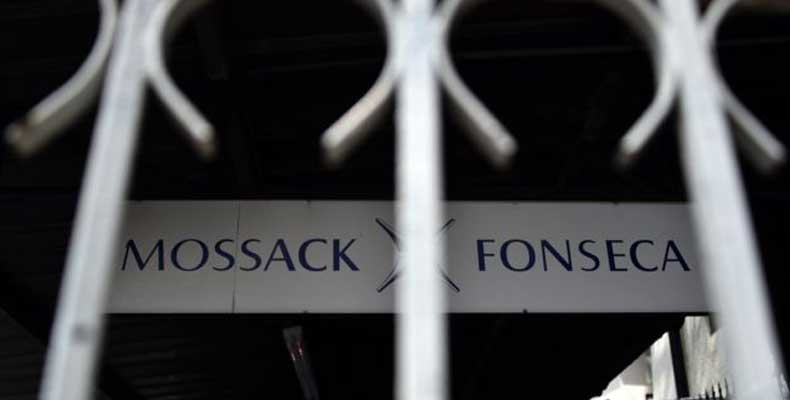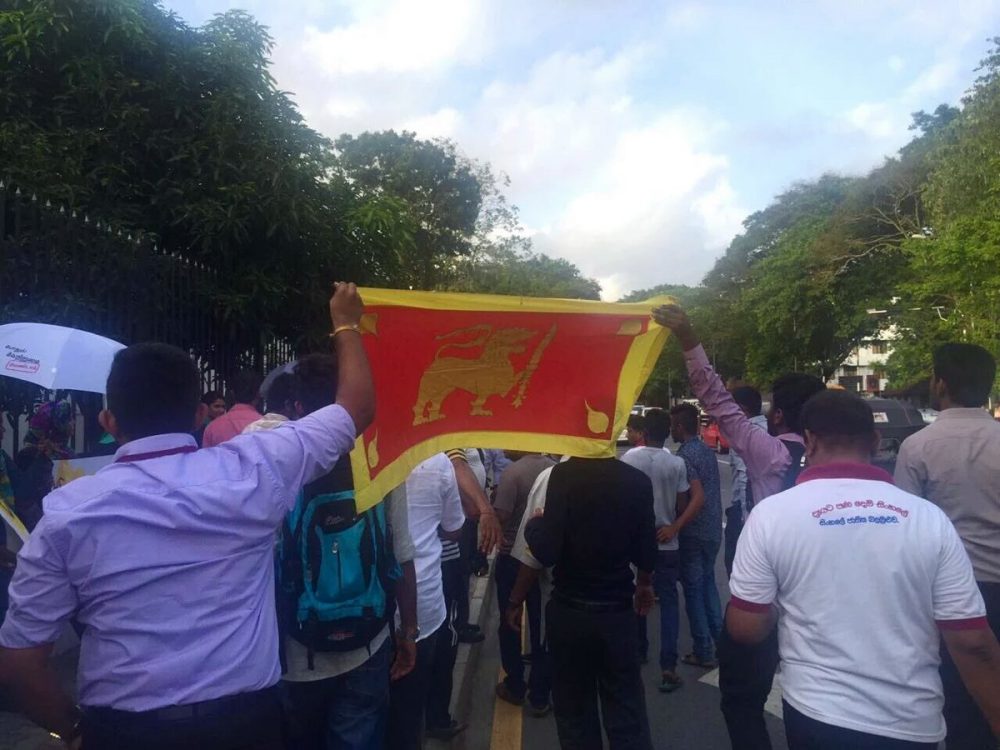
Earlier this month, on August 15, a social media group who gathered under the banner ‘Different Yet Equal’ held a silent vigil at Bauddhaloka Mawatha near Independence Arcade, holding up white umbrellas and signs promoting equality.
The Different Yet Equal group soon attracted more participants who held signs in all three languages which read “We all have the same blood” as a stand against racism. This seemingly peaceful vigil was then disrupted by another group with flags bearing the ‘Sinha-Le’ slogan ‒ a slogan which has been mired in controversy since it first gained popularity.
A Brief History Of Sinha-Le

The leaders of the Sinha-Le movement at a press briefing in January this year. Image courtesy lankahotnews.co.uk
The end of the civil war in 2009 brought with it a fragile, tenuous peace that was soon shattered in 2014 by the hardline Bodu Bala Sena (BBS), headed by Ven. Galagodaaththe Gnanasara Thera. The BBS was blamed for several clashes and incidents involving the incitement of racist sentiments, the Aluthgama clash being among the most prominent.
While the activities of the BBS appeared to simmer down after the arrest of their infamous leader Gnanasara Thera at the beginning of this year, we witnessed the rise of yet another group advocating racial bias, known simply as ‘Sinha-Le.’ They first gained popularity through a sticker campaign which went viral. At this point, however, there was still some ambiguity about the origins of the campaign, with many giving it the benefit of doubt, considering the somewhat ambiguous ‘Sinha-Le’ tag. It was also unknown whether or not ‘Sinha-Le’ was an organised group to begin with, or simply what it appeared to be: a tuk tuk sticker campaign.
Recently, however, the Sinha-Le group shed all vestiges of ambiguity and formed their own political party, titled the “Sinhale Jathika Balamuluwa” (SJB), advocating “purity” of blood.
When Roar contacted the General Secretary of the SJB, Ven. Madille Pagnaloka Thera, he explicitly stated that the only true Sri Lankans are the Sinhalese who share the “Lion’s Blood.”
“Sinhale was the term used for the country, which is presently going by the name of Sri Lanka,” he claimed, adding that “the minority communities are not truly Sri Lankan.”
What Happened On The Day Of The Vigil?
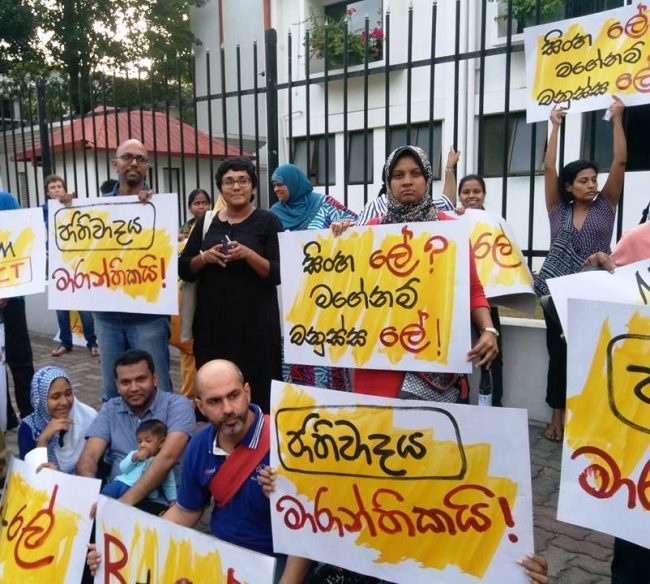
The Different Yet Equal vigil was attended by citizens of diverse backgrounds, in an attempt to speak out against racism and intolerance. Image courtesy Different Yet Equal
Speaking about the incident that took place on August 15, a representative of the Sinha-Le movement said that they were merely opposing the use of the phrase “Ekama-Le”.
“They were misusing the term Sinha-Le. They kept saying “Ekama-Le” and in doing so they insulted Sinha-Le. They didn’t even know what they were talking about,” the representative told Roar.
The vigil, meanwhile, was an attempt to promote a more positive attitude towards racial differences. Speaking to Roar, a spokesperson for the Different Yet Equal group said that Different Yet Equal was initiated after the Sinha-Le movement began disseminating their message that Sri Lanka belongs only to the Sinhala majority, and that the green and orange stripes (representing the Muslim and Tamil minorities respectively) on the Sri Lankan flag should be removed.
In a move to counteract the popular Sinha-Le sticker campaign, Different Yet Equal handed out stickers condemning racism.
“Most people driving, including trishaw drivers, asked for or accepted the stickers when we explained that ‘api ajathiwadeta virudday’ (we are against communalism/racism), and some struck up positive discussions,” the group added.
Shortly afterwards, however, the Sinha-Le group showed up, allegedly holding the modified version of the Sri Lankan flag, and attempted to disrupt the proceedings.
“The group of Sinha-Le supporters turned up, were aggressive, abusive, and intimidating; they threatened people at our vigil, snatched posters and tore them apart,” the group told Roar.
The Sinha-Le Agenda
If the group’s behaviour at the vigil didn’t raise enough alarm bells, the philosophy behind their actions should. In an attempt to learn more about their agenda, we spoke to Ven. Madille Pannaloka Thera and allowed him to elaborate. He made it very clear that the Sinha-Le movement was all about the pride of the Sinhalese Nation – and this completely leaves minorities out of the equation.
“Sri Lanka is a country that belongs to the Sinhala people. We are simply proud of this fact and only the Sinhalese are true Sri Lankans. No one can disagree that even historically, Sri Lanka was considered a Sinhala Nation. The various other communities came in and divided our country, declaring it multi-national. This is wrong,” the Thera said.
The Thera further stated that the Sri Lankan National Flag is an insult to our ‘Sinhala Nation’ because it shows ‘division’.
“Take a look at the flag. It doesn’t show multiculturalism. It shows division. The green and orange stripes have invaded the flag in a way that promotes division. This is why we believe those stripes that denote division should be removed and the flag should be amended to just the lion and the bo leaves as is right.”
It should also be noted that the General Secretary of Sinha-Le, Ven. Madille Pannaloka Thera was also the general secretary of the Sinhala Ravaya, a group whose rhetoric is very similar to that of the BBS. The Sinhala Ravaya briefly entered the limelight in 2014 and 2015 when they held a number of demonstrations and protests, while the Thera himself had an arrest warrant issued in his name, but the group seems to have gone quiet since. Even their Facebook page cannot seem to muster more than 20 likes per post, unlike the Sinha-Le movement, which seems to have levelled up their game.
Why We Should No Longer Give Sinha-Le The Benefit Of The Doubt
Perhaps the most important lesson we learnt from the Different Yet Equal campaign, apart from the fact that there are people actively resisting racism, is that Sinha-Le is most definitely racist ‒ there’s no point in pretending otherwise.
In the days following Sinha-Le’s attempt to crash the vigil, the Prime Minister called for a probe into their activities, while on Facebook, they seem to be receiving an increase in traction. Sinha-Le, however, is not the first group to use the seemingly innocuous internet, via social media, to spread their message of racial intolerance to a mass of unsuspecting and, often, uncritical readers and casual browsers.
Their Facebook page, which has almost 125,000 likes, is riding on the tide of “shareable” posts, effortlessly disseminating racial intolerance packaged as internet truisms.They no doubt seem to have the hang of how the modern world works; tapping into the viral culture via a sticker campaign, parading themselves on social media, and making themselves known widely by attractively designed stickers. Their PR is impeccable, despite the fact that you would probably be hard-pressed to find an actual tuk tuk driver who knows what it really means ‒ and that’s scary, because they seem to have thrived on a wave of ambiguity and used it to their advantage.
We could remain silent, of course. As we always have until things get out of hand ‒ take Aluthgama, for example. We dismissed the BBS until they showed what they were capable of. We could, of course, stick to reporting their Facebook page, where they proudly talk of their “return” from the social media graveyard, but as their return has demonstrated, the movement is like Hydra: they will resurface, somehow or the other.
The real question, then, is: how do you combat something like racism that has learnt to package itself so attractively, and thrive, both on the internet and in the tangible, real world? The answer isn’t straightforward: but one thing is for sure, attempts at making a more inclusive society need to go beyond the confines of Colombo, and this is something that even groups like Different Yet Equal, which attempt to combat racism, need to take into account.
Featured image courtesy Twitter/@GunathilakeNet

